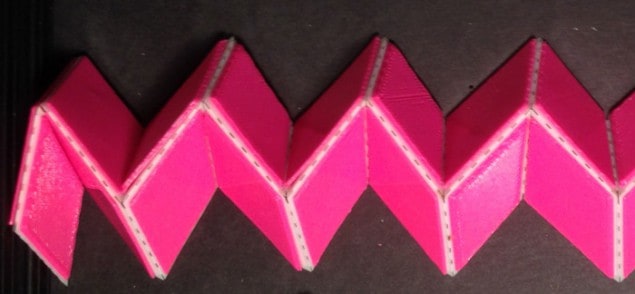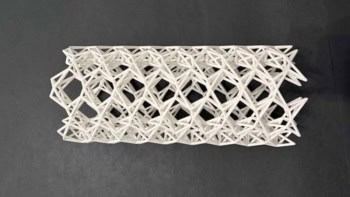
A metamaterial that is soft along one edge and rigid along the other, yet also displays mechanical topological properties, has been developed by an international team of researchers. This is the first time that topological origami and kirigami techniques have been applied experimentally to metamaterials – artificial materials with tunable, well-defined properties. Apart from having developed a metamaterial with two distinct topological phases, the team is also working on theoretical guidelines for the future design and development of such materials.
Researchers have become increasingly interested in recent years in using he ancient Japanese arts of paper folding and cutting – origami and kirigami, respectively – to build and create a variety of metamaterials. Indeed, Bryan Gin-ge Chen, at the University of Massachusetts Amherst, who led the latest work, sees origami as one of the earliest examples of a metamaterial. “All designs are folded from a square sheet of paper, but many different shapes and structures can result, [which] is exactly in line with the principle that a metamaterials’ properties come from structure rather than composition,” he explains.
Chen and colleagues in the US and the Netherlands were inspired by the novel idea of “topological mechanics”, developed in 2014 by Charles Kane and Tom Lubensky from the University of Pennsylvania. Originating from the topological states seen in quantum physics, the idea was extended by Kane and Lubensky, who showed that there is a special class of mechanical structures that can be “polarized” so they are soft or floppy along one side, while being hard or rigid along the other.
Special class
“What’s special about these topologically polarized materials is that if you cut the system in half, each of the two new pieces now has a rigid side and a floppy side too,” says Chen. The two new surfaces created by making such a cut, he explains, “somehow know how they are to act, just like how cutting a magnet in two leaves you with two magnets, not a separate North and South pole”.
Since Kane and Lubensky’s 2014 paper, many other researchers have modelled how such materials could be exploited in a system with masses connected by springs. Chen and his team have instead developed theoretical tools to find such behaviour in origami and kirigami structures. Their aim has been to design origami structures that can flex and deform controllably, which will be necessary for future “smart” materials that can evolve their shape or properties at will. The team then applied its designs to create a simple origami strip that shows the edge deformations that would arise from topological polarization.
The structure is a series of four-sided plastic units connected using hinges. By squashing it between two plates, the team could make the material buckle at the hinges to form valley-like structures. The pattern was designed so the material is asymmetrically rigid along its length.
Degrees of freedom
Another benefit of the materials’ flexibility arising from the topological polarization is that it can withstand some imperfection in how it is built, Chen explains. The team also saw interesting effects – such as additional flexibility or rigidity – that appear when different origami designs are side-by-side in a composite sheet.
Chen adds that for structures that are not too rigid or floppy, a careful balancing and accounting of the material’s “degrees of freedom (DOF) and the constraints between them is fundamentally important for a mechanical structure”. His colleague Vincenzo Vitelli from the University of Leiden in the Netherlands says that the DOFs simply mean that the material can fold in some places and not in others, and do not depend on local properties like material parameter variations.
Chen cautions that the guidelines the team is developing are still a work in progress. “We know that ‘topological’ origami and kirigami materials must have a precise balance of DOF and constraints in each unit cell,” he says. “It also seems that in order to get topologically polarized structures consisting of patterns that repeat in two directions, we have to include holes (a kirigami structure), unlike the 1D repeating strip.” However, his team is still investigating how the angles and pattern of creases determines the topological polarization in different cases. According to Chen, the current work lays the foundation for future studies on origami and kirigami as “topological metamaterials”.
The research is published in Physical Review Letters.



